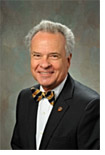Q&A with Dr. Frank L. Douglas, President & CEO, Austen BioInnovation Institute and Dr. George R. Newkome, President, University of Akron Research Foundation

Dr. Frank L. Douglas
An award-winning industry veteran with nearly three decades of experience as a leader in healthcare, pharmaceutical research and entrepreneurship, Dr. Frank L. Douglas is President and CEO of the Austen BioInnovation Institute in Akron.
Additionally, he is University Professor in the College of Polymer Science and Engineering at The University of Akron, Professor of Integrated Medical Sciences at Northeast Ohio Medical University, member of the Ewing Marion Kauffman Foundation's Board of Trustees, and senior partner emeritus of PureTech Ventures. Douglas currently is the national chairman of the Value-driven Engineering and U.S. Global Competitiveness initiative, a public-private coalition made up of leaders from industry, academia and the public and private sectors working to retain the United States' lead in medical device development and innovation.
While at Massachusetts Institute of Technology (MIT), Douglas was the Professor of the Practice in the MIT Sloan School of Management and held similar appointments in the departments of biology, biological engineering, and the Harvard-MIT Division of Health Sciences and Technology. He was also the founder and first executive director of the MIT Center for Biomedical Innovation and formerly executive vice president, chief scientific officer, and a member of the board of management of Aventis, where he headed drug innovation and approval, with global responsibilities for research, development, and regulatory and marketing support.

Dr. George Newkome
Dr. George Newkome is Vice President for Research and Dean of the Graduate School at The University of Akron. Since joining the University in 2001, Newkome has led efforts to expand its research infrastructure and broaden linkages with industries and foundations, as well as increasing integration of research and graduate education. Newkome, who also serves as president and CEO of The University of Akron Research Foundation, founded in 2003, as well as president of the Akron Innovation Campus, has made seminal contributions to the fields of chemistry and polymer science, including his pioneering work in 1985 on advanced molecular structures called dendrimers.
In addition, The Ohio Academy of Science appointed Newkome as an Honorary Fellow in May 2011. Newkome, a polymer scientist and chemist, was one of five Ohioans who received the distinction for rendering special services to the Ohio Academy of Science or for making extensive, productive scientific, technological or educational contributions to society. Academy Fellows of 2011 contributed to the fields of polymer chemistry, aerospace engineering, medicine, pre-med studies and science literacy, microbiology, science and science policy, botany and ecology.
Prior to arriving at UA, Newkome was vice president for research at the University of South Florida. Newkome began his career as a postdoctoral fellow at Princeton University, and later joined Louisiana State University where he became a full professor and the LSU Distinguished Research Master.
Q.The Austen BioInnovation Institute in Akron and University of Akron Research Foundation’s “Innovative Solutions for Invention Xceleration" (ISIX) project is among the winners of the inaugural i6 Challenge in 2010. What is the status of the initiative?
A:The project “Innovative Solutions for Invention Xceleration” (ISIX) aims to increase innovation and minimize the time from idea to commercialization of new technology by bringing together world-class scientists, physicians, engineers, researchers and entrepreneurs in the biomedical devices and polymer science industries of Northeast Ohio. In the nine months since the official start of our ISIX program, significant progress has been made deploying the principles outlined in the ISIX proposal as an overarching methodology for everything that we do to stimulate entrepreneurship, company creation and job growth. The ABIA-UARF team is on track to reach or exceed all of the first-year milestones.
To date, the goal for number of invention disclosures submitted has been surpassed (goal of 50, to date 90 submitted) and the team is rapidly approaching its annual goal for funding through the Technology Development Fund, which facilitates continued development of promising technologies by funding such aspects as prototype development, market analysis and intellectual property review. Our success in increasing quality of invention disclosures is due to many efforts including our Structured Invention sessions, a program that brings clinicians, researchers and biomechanical engineers together to identify solutions in an intimate session that couples fundamental scientific insights with those gained from the clinical use of thousands of medical products.
The Collaborative Research and Development (CRD) grant program has enabled researchers within ABIA’s founding members to move technology ideas closer to commercialization, and the annual CRD symposia bring together these teams to discuss their projects, and to identify potential collaborators as well as gain valuable input. Additionally, our monthly Synergy Seminars have brought together more than 500 potential “problem owners” with “solution providers” in stimulating discussions that have already led to the creation of innovation teams, and six projects, bent on providing new treatments for the waiting patients.
Our entrepreneurial support efforts include the very successful pilot of the ABIA-UA Women’s Entrepreneurship Program (WEP) launched with eight teams of technologists and graduate business students and provided exposure to experienced biomedical developers, regulatory experts, intellectual property development and business plan writing. The teams are pushing several biomedical and alternative energy projects toward a path that facilitates commercialization of technology leading to spin out companies or licensing opportunities. Projects the teams are working on include developing a drug-eluting polymer tape for use on implantable medical devices, a unified battery management system, and social media-delivered personalized healthcare interventions. Further, courses that stimulate an entrepreneurial education have been added including the Akron Innovation through Convergence and Entrepreneurship Program, Integrative Graduate Education and Research Traineeship and the BioInnovation Design Course.
On the industry front, the ABIA-UARF team opened the Akron Functional Materials Center (AFMC). This unique national research resource focuses on elevating the technology readiness level of research discoveries and new polymer materials through a suite of open source, research-level facilities coupled with established “combi tools” dedicated to assist researchers, industry and innovators with the design, fabrication and optimization of polymers and advanced materials. The AFMC will target companies globally for participation and membership, and has 14 initial corporate members. Its six technical working groups include nanomaterials, complex fluids, biomaterials, adhesion, membranes and automation. Additionally, the Akron team has nearly met its goal in support to small companies with SBIR grant partnerships with three companies to date out of our goal of four.
These are just some highlights of the many activities described in ISIX that have been successfully implemented to date.


